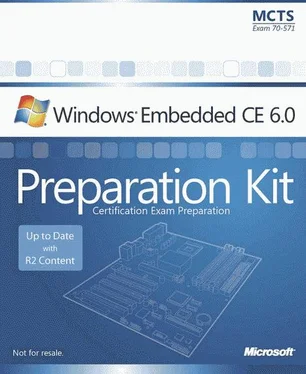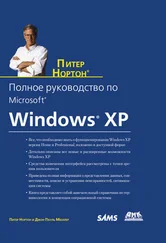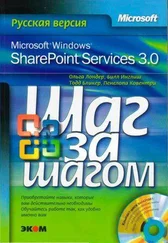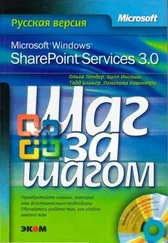Nicolas Besson - Microsoft Windows Embedded CE 6.0 Exam Preparation Kit
Здесь есть возможность читать онлайн «Nicolas Besson - Microsoft Windows Embedded CE 6.0 Exam Preparation Kit» весь текст электронной книги совершенно бесплатно (целиком полную версию без сокращений). В некоторых случаях можно слушать аудио, скачать через торрент в формате fb2 и присутствует краткое содержание. Город: Redmond, Год выпуска: 2008, Издательство: Microsoft, Жанр: Руководства, ОС и Сети, Программы, на английском языке. Описание произведения, (предисловие) а так же отзывы посетителей доступны на портале библиотеки ЛибКат.
- Название:Microsoft Windows Embedded CE 6.0 Exam Preparation Kit
- Автор:
- Издательство:Microsoft
- Жанр:
- Год:2008
- Город:Redmond
- ISBN:нет данных
- Рейтинг книги:5 / 5. Голосов: 1
-
Избранное:Добавить в избранное
- Отзывы:
-
Ваша оценка:
- 100
- 1
- 2
- 3
- 4
- 5
Microsoft Windows Embedded CE 6.0 Exam Preparation Kit: краткое содержание, описание и аннотация
Предлагаем к чтению аннотацию, описание, краткое содержание или предисловие (зависит от того, что написал сам автор книги «Microsoft Windows Embedded CE 6.0 Exam Preparation Kit»). Если вы не нашли необходимую информацию о книге — напишите в комментариях, мы постараемся отыскать её.
Microsoft Windows Embedded CE 6.0 Exam Preparation Kit — читать онлайн бесплатно полную книгу (весь текст) целиком
Ниже представлен текст книги, разбитый по страницам. Система сохранения места последней прочитанной страницы, позволяет с удобством читать онлайн бесплатно книгу «Microsoft Windows Embedded CE 6.0 Exam Preparation Kit», без необходимости каждый раз заново искать на чём Вы остановились. Поставьте закладку, и сможете в любой момент перейти на страницу, на которой закончили чтение.
Интервал:
Закладка:
// Thread function
DWORD WINAPI ThreadProc(LPVOID lpParameter) {
// Perform thread actions...
// Exit the thread.
return ERROR_SUCCESS;
}
BOOL bRet = FALSE;
THREAD_PARAM_T threadParams;
threadParams.bStop = FALSE;
DWORD dwExitCodeValue = 0;
// Create the thread in suspended mode.
HANDLE hThread = CreateThread(NULL, 0, ThreadProc,
(LPVOID) &threadParams, CREATE_SUSPENDED, NULL);
if (hThread == NULL) {
// Manage the error...
} else {
// Change the Thread priority.
CeSetThreadPriority(hThread, 200);
// Resume the thread, the new thread will run now.
ResumeThread(hThread);
// Perform parallel actions with the current thread...
// Wait until the new thread exits.
WaitForSingleObject(hThread, INFINITE);
// Get the thread exit code
// to identify the reason for the thread exiting
// and potentially detect errors
// if the return value is an error code value.
bRet = GetExitCodeThread(hThread, &dwExitCodeValue);
if (bRet && (ERROR_SUCCESS == dwExitCodeValue)) {
// Thread exited without errors.
} else {
// Thread exited with an error.
}
// Don't forget to close the thread handle
CloseHandle(hThread);
}
Thread Synchronization
The real art of multithreaded programming lies in avoiding deadlocks, protecting access to resources, and ensuring thread synchronization. Windows Embedded CE provides several kernel objects to synchronize resource access for threads in drivers or applications, such as critical sections, mutexes, semaphores, events, and interlocks functions. Yet, the choice of the object depends on the task that you want to accomplish.
Critical Sections
Critical sections are objects that synchronize threads and guard access to resources within a single process. A critical section cannot be shared between processes. To access a resource protected by a critical section, a thread calls the EnterCriticalSection function. This function blocks the thread until the critical section is available.
In some situations, blocking the thread execution might not be efficient. For example, if you want to use an optional resource that might never be available, calling the EnterCriticalSection function blocks your thread and consumes kernel resources without performing any processing on the optional resource. It is more efficient in this case to use a critical section without blocking by calling the TryEnterCriticalSection function. This function attempts to grab the critical section and returns immediately if the critical section cannot be used. The thread can then continue along an alternative code path, such as to prompt the user for input or to plug in a missing device.
Having obtained the critical section object through EnterCriticalSection or TryEnterCriticalSection, the thread enjoys exclusive access to the resource. No other thread can access this resource until the current thread calls the LeaveCriticalSection function to release the critical section object. Among other things, this mechanism highlights why you should not use the TerminateThread function to terminate threads. TerminateThread does not perform cleanup. If the terminated thread owned a critical section, the protected resource becomes unusable until the user restarts the application.
Table 3-11 lists the most important functions that you can use to work with critical section objects for thread synchronization purposes.
Table 3-11 Critical Section API
| Function | Description |
|---|---|
| InitializeCriticalSection | Create and initialize a critical section object. |
| DeleteCriticalSection | Destroy a critical section object. |
| EnterCriticalSection | Grab a critical section object. |
| TryEnterCriticalSection | Try to grab a critical section object. |
| LeaveCriticalSection | Release a critical section object. |
Mutexes
Whereas critical sections are limited to a single process, mutexes can coordinate mutually exclusive access to resources shared between multiple processes. A mutex is a kernel object that facilitates inter-process synchronization. Call the CreateMutex function to create a mutex. The creating thread can specify a name for the mutex object at creation time, although it is possible to create an unnamed mutex. Threads in other processes can also call CreateMutex and specify the same name. However, these subsequent calls do not create new kernel objects, but instead return a handle to the existing mutex. At this point, the threads in the separate processes can use the mutex object to synchronize access to the protected shared resource.
The state of a mutex object is signaled when no thread owns it and non-signaled when one thread has ownership. A thread must use one of the wait functions, WaitForSingleObject or WaitForMultipleObjects, to request ownership. You can specify a timeout value to resume thread processing along an alternative code path if the mutex does not become available during the wait interval. On the other hand, if the mutex becomes available and ownership is granted to the current thread, do not forget to call ReleaseMutex for each time that the mutex satisfied a wait in order to release the mutex object for other threads. This is important because a thread can call a wait function multiple times, such as in a loop, without blocking its own execution. The system does not block the owning thread to avoid a deadlock situation, but the thread must still call ReleaseMutex as many times as the wait function to release the mutex.
Table 3-12 lists the most important functions that you can use to work with mutex objects for thread synchronization purposes.
Table 3-12 Mutex API
| Function | Description |
|---|---|
| CreateMutex | Create and initialize a named or unnamed mutex object. To protect resources shared between processes, you must use named mutex objects. |
| CloseHandle | Closes a mutex handle and deletes the reference to the mutex object. All references to the mutex must be deleted individually before the kernel deletes the mutex object. |
| WaitForSingleObject | Waits to be granted ownership of a single mutex object. |
| WaitForMultipleObjects | Waits to be granted ownership for a single or multiple mutex objects. |
| ReleaseMutex | Releases a mutex object. |
Semaphores
Apart from kernel objects that enable you to provide mutually exclusive access to resources within a process and between processes, Windows Embedded CE also provides semaphore objects that enable concurrent access to a resource by one or multiple threads. These semaphore objects maintain a counter between zero and a maximum value to control the number of threads accessing the resource. The maximum value amount is specified in the CreateSemaphore function call.
The semaphore counter limits the number of threads that can access the synchronization object concurrently. The system will keep decrementing the counter every time a thread completes a wait for the semaphore object until the counter reaches zero and enters the nonsignaled state. The counter cannot decrement past zero. No further thread can gain access to the resource until an owning thread releases the semaphore by calling the ReleaseSemaphore function, which increments the counter by a specified value and again switches the semaphore object back into signaled state.
Читать дальшеИнтервал:
Закладка:
Похожие книги на «Microsoft Windows Embedded CE 6.0 Exam Preparation Kit»
Представляем Вашему вниманию похожие книги на «Microsoft Windows Embedded CE 6.0 Exam Preparation Kit» списком для выбора. Мы отобрали схожую по названию и смыслу литературу в надежде предоставить читателям больше вариантов отыскать новые, интересные, ещё непрочитанные произведения.
Обсуждение, отзывы о книге «Microsoft Windows Embedded CE 6.0 Exam Preparation Kit» и просто собственные мнения читателей. Оставьте ваши комментарии, напишите, что Вы думаете о произведении, его смысле или главных героях. Укажите что конкретно понравилось, а что нет, и почему Вы так считаете.








